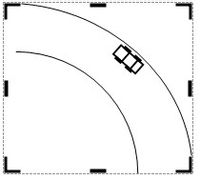Question
The figure below shows a 1,000 kg car traveling in a counterclockwise along a circular path. If the radius of curvature of the road is 103 m and the maximum friction force on the car is 1391 N, determine the maximum speed of the car around the curve.

Transcribed Image Text:L.
Expert Solution
This question has been solved!
Explore an expertly crafted, step-by-step solution for a thorough understanding of key concepts.
Step by stepSolved in 2 steps with 1 images

Knowledge Booster
Similar questions
- Friction provides the force needed for a car to travel around a flat, circular race track. What is the maximum speed at which a car can safely travel if the radius of the track is 80 m and the coefficient of friction is 0.4?arrow_forwardA 0.6 kg ball moves in a vertical circle on a 1m long string. If the speed at the top is 3.80 m/s, then the speed at the bottom will be 7.53 m/s. (a)What is the tension in the string when the ball is at the top? (b)What is the tension in the string when the ball is at the bottomarrow_forwardA stone, of mass m, is attached to a strong string and whirled in a vertical circle of radius r. At the exact bottom of the path the tension in the string is 2 times the stone's weight. The stone's speed at this point is given byarrow_forward
- The coefficient of friction acting upon a 945-kg car is 0.850. The car is making a 180-degree turn around a curve with a radius of 35.0 m. Determine the maximum speed with which the car can make the turn.arrow_forwardAn RC car drives around in a circle of radius 1.00 m. The coefficient of static friction between the tires and the floor is 0.85; the coefficient of kinetic friction is 0.60. The mass of the car is 400 g, and its speed is 2.5 m/s. What is the maximum speed at which the car could travel and still move in the same circle ?arrow_forwardDuring an Olympic bobsled run, the Jamaican team makes a turn of radius 8.80 m at a speed of 97.6 km/h. What is the ratio of their acceleration to g?arrow_forward
- A body is moving along a circular path of radius 2.86 m. If the centripetal force on the body is three times its weight, find the period of the motion.arrow_forwardIt is well known that runners run more slowly around a curved track than a straight one. One hypothesis to explain this is that the total force from the track on a runner's feet--the magnitude of the vector sum of the normal force (that has average value mgmg to counteract gravity) and the inward-directed friction force that causes the runner's centripetal acceleration--is greater when running around a curve than on a straight track. Runners compensate for this greater force by increasing the time their feet are in contact with the ground, which slows them down. For sprinters running at 8 m/s around a curved track of radius 16 m, how much greater (as a percentage) is the average total force on their feet compared to when they are running in a straight line?arrow_forwardA ball is on the end of a string. The ball is being swung in a vertical circle at a constant speed. The length of the string is 1.25 m. The mass of the ball is 2.10 kg. The maximum tension the string can withstand is 61.0 N. What is the max speed of the ball without breaking the string when the ball is at the top of the circle (point a)?arrow_forward
- A small object of mass 0.20 kg is whirled in a horizontal circle at the end of the 1 m long cord. What is the highest speed that the object can have if the cord can sustain a maximum force of 4 newtons without breaking?arrow_forwardA 1.5kg rock is tied to the end of a 1.25m string and is swung in a vertical circle at a constant speed of 4.5 m·s−1. If the string breaks when the tension is 135 N, calculate the maximum speed that the rock can be swung without breaking the string?arrow_forwardThe maximum speed with which a 945-kg car makes a 180-degree turn is 10.0 m/s. The radius of the circle through which the car is turning is 25.0 m. Determine the force of friction and the coefficient of friction acting upon the car.arrow_forward
arrow_back_ios
SEE MORE QUESTIONS
arrow_forward_ios